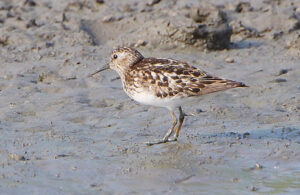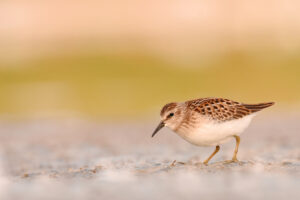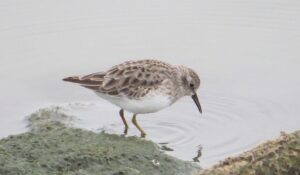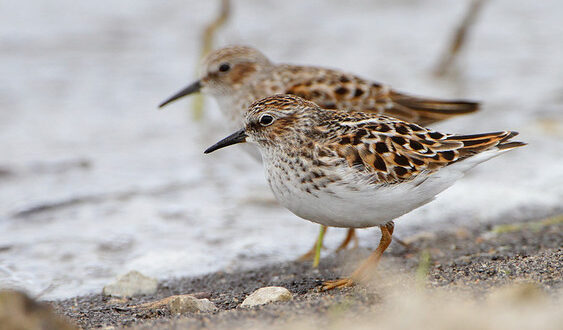Least Sandpiper, Calidris minutilla
Bill Rowe
Shorebirds are back now, though “back” simply means passing through again on their return trip south from Canada and Alaska, where they nested. For most of them, this occurred on the Arctic tundra; they have had a long journey to get here, and they have a long one yet ahead of them to their winter quarters. Worldwide, the smallest shorebirds are the little sandpipers that we call “peeps” and the British call “stints”—seven species in all, three of them North American. The smallest one of all, on average, is the Least Sandpiper, which we get to see over a wide span of dates as they make their way down through the Midwest, from early July through August/September and on even into December in recent years. The key to seeing them, as with most shorebirds, is finding their habitat: they need mud, blending into shallow water and/or a grassy margin. There they pick away at the tiny worms, crustaceans, flies, etc., that constitute their food supply and keep them going. This habitat is transient in our part of the world, shifting from one spot to another at the whim of rainfall, river levels, and human use of land; we don’t have the regularity of tidal marshes and beaches, or of refuges that cater to shorebird migration. And yet, most years, some shorebirds can be found if you keep looking, and the Least Sandpiper is common enough to make it a staple species among this group, a good one to learn well.
IDENTIFICATION: To learn shorebirds, start with size and shape. Least Sandpipers are sparrow-size, compact and short-tailed, with shortish legs, feeding on the mud in a sort of crouched posture. Their bill is thin and slightly decurved and tapers to a fine point. If you get a close look, you’ll see that their legs are yellow or greenish, separating them from other small-to-medium sandpipers, which have blackish legs; an exception is the Pectoral Sandpiper, also with yellow legs, but it is much larger. These points—size, shape, and leg color—are consistent, while plumage colors are not. In general, Least Sandpipers are brown above and white below, with some streaking on the breast, but note these variations: (1) Adults in spring (fresh breeding plumage) have large wing feathers in bright patterns of black, white, and rust; see the photo above (May). (2) Adults in late summer (worn breeding plumage) look darker and messier (see below). (3) Juveniles in August/September are in their own special plumage, with smaller, neater, brightly colored wing feathers (also below). (4) Both adults and juveniles in late fall and winter have molted into non-breeding plumage; they are grayer and more uniform (also below). That’s a lot of detail, but it may help in sorting out and appreciating these little guys.
ST. LOUIS STATUS: Common spring and fall migrants in the right habitat; may also be found into the winter at times.
Learn more and listen to the calls of Least Sandpipers here.



Adult in worn breeding plumage (Aug)
Photo Credit: Al Smith
Juvenile plumage (Aug)
Nonbreeding plumage (Oct)
Photo Credit: Bill Rowe




